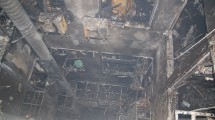Abstract
In this study, the stair pressurization system in a 40-storey high office building in Istanbul is investigated through field tests, in order to understand the effect of the presence of a non-pressurized vestibule (fire protection lobby, FPL) before entering the stair at each floor. The building without FPL is simulated by keeping only one of the two doors (of the stair and FPL) open at each floor. This method gave an opportunity to fix other parameters affecting the stair pressurization system and check solely the effect of FPL. Two different cases are taken into account, where the first one (all doors closed) analyses the condition that all stair doors are kept closed and the second one (critical doors are open) is conducted when the stairwell is opened to the floor on a given level (fire floor) and the stair termination door at the discharge floor is kept open. For both cases, the availability of the FPL is investigated by using the aforementioned arrangement. Under the conditions with approximately the same pressurized air flow rate at all doors closed condition, it is found that the availability of FPL increases the pressure difference between the stairwell and the corridor by a factor of approximately 2.2. This is also justified by using empirical formulations available in literature, where this ratio is calculated as 2.0. The results of this study showed that the FPL arrangement improves the effectiveness of pressurization system in a very high-rise building, despite some tolerable drawbacks.








Similar content being viewed by others
References
Wang Y, Gao F (2004) Tests of stairwell pressurization systems for smoke control in a high-rise building. ASHRAE Trans, 110:185–193
Chung KC (1999) Evaluation of smoke exhaustion performance of a vestibule within tall buildings in Taiwan. Int J Eng Perform Based Fire Codes, 1:71–80
Kim JY, Shin HJ, Ahn CS, Kim JS, Joo SH (2014) Development of the separate air-supply type of pressurization smoke control system for the stairwells of high-rise buildings in Korea. Open J Fluid Dyn 4:251–262. doi:10.4236/ojfd.2014.43019
NFPA (2012) NFPA 92® Standard for smoke control systems. National Fire Protection Association, Massachusetts
BSI (2005) BS EN 12101-6:2005 Smoke and heat control systems—Part 6: specification for pressure differential systems—Kits. CEN, Brussels
BSI (1998) BS 5588-4:1998 Fire precautions in the design, construction and use of buildings—Part 4: code of practice for smoke control using pressure differentials. BSI
TÜYAK (2012). Turkey’s regulation on fire protection regulation on fire protection of buildings. Turkish Fire Protection and Education Foundation, Istanbul
De Cicco PR, Cresci RJ, Correale WH (1972) Report of fire tests, analyses and evaluation of stair pressurization and exhaust in high-rise office buildings. Polytechnic Institute of Brooklyn Center for Urban Environmental Studies, Baywood Publishing Company
Shaw CY, Tamura GT (1976) Design of a stairshaft pressurization system for tall buildings. ASHRAE J 18(2):29–33
Tamura GT (1989) Stair pressurization systems for smoke control: design considerations. ASHRAE Trans 95(2):184–192
Tamura GT (1991) Determination of critical air velocities to prevent smoke backflow at a star door opening on the fire floor. ASHRAE Trans 97(2):627–633
Tamura GT (1974) Experimental studies on pressurized escape routes. ASHRAE Trans 80(2):224–237
Tamura GT, Shaw CY (1976) Air leakage data for the design of elevator and stair shaft pressurization systems. ASHRAE Trans 82(2):179–190
Tamura GT, Shaw CY (1978) Experimental studies of mechanical venting for smoke control in tall office buildings. ASHRAE Trans 84(1):54–71
Tamura GT, Shaw CY (1976) Studies on exterior wall air tightness and air infiltration of tall buildings. ASHRAE Trans 82(1):122–134
Shaw CY, Reardon JT, Cheung MS (1993) Changes in air leakage levels of six Canadian office buildings. ASHRAE J 35(2):34–36
Tamura GT (1990) Fire tower tests of stair pressurization systems with overpressure relief. ASHRAE Trans 96(2):373–383
Tamura GT (1990) Field tests of stair pressurization systems with overpressure relief. ASHRAE Trans 96(1):951–958
Chow W, Lam LW (1993) 3710 evaluation of a staircase pressurization system. ASHRAE Trans 99(2):194–199
[20] Bellido C, Quiroz A, Panizo A, Torero JL (2009). Performance assessment of pressurized stairs in high rise buildings. Fire technology 45(2):189–200
Tamura GT (1994) Fire tower tests on vestibule pressurization for protection of stairshafts. ASHRAE Trans 100(1):981–989
Kujime M, Matsushita T, Tanaka T (1999) Hand calculation method for air supply rates in vestibule pressurization smoke control system. Int J Eng Perform Based Fire Codes 1(1):27–40
Klote JH, Milke JA (2002) Principles of Smoke Management. American Society of Heating, Refrigerating and Air-Conditioning Engineers, Inc., Atlanta
Hobson PJ, Stewart LJ (1972) Pressurization of escape routes in buildings. Fire Research Notes 958. Heating, Ventilating Research Association
Acknowledgment
The authors are thankful to the administration of Ozdilek Center Complex, for permission to use the River Plaza office building and to the technical and security staff for their support during the field tests.
Author information
Authors and Affiliations
Corresponding author
Rights and permissions
About this article
Cite this article
Hepguzel Acikyol, B., Balik, G. & Kilic, A. Experimental Investigation of the Effect of Fire Protection Lobby on Stair Pressurization System in a High-Rise Building. Fire Technol 53, 135–151 (2017). https://doi.org/10.1007/s10694-015-0560-4
Received:
Accepted:
Published:
Issue Date:
DOI: https://doi.org/10.1007/s10694-015-0560-4




